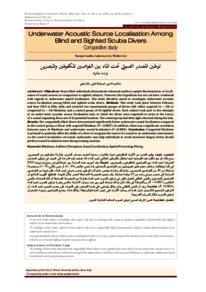Document
Underwater acoustic source localisation among blind and sighted scuba divers.
Identifier
doi: 10.18295/squmj.2016.17.02.006
Contributors
Livi, Ludovica., Author
Livi, Walter., Author
Other titles
توطين المصدر الصوتي تحت الماء بين الغواصين المكفوفين والمبصرين
Publisher
College of Medicine, Sultan Qaboos University.
Gregorian
2017-05
Language
English
English abstract
Many blind individuals demonstrate enhanced auditory spatial discrimination or localisation
of sound sources in comparison to sighted subjects. However, this hypothesis has not yet been confirmed
with regards to underwater spatial localisation. This study therefore aimed to investigate underwater acoustic
source localisation among blind and sighted scuba divers. Methods: This study took place between February
and June 2015 in Elba, Italy, and involved two experimental groups of divers with either acquired (n = 20) or
congenital (n = 10) blindness and a control group of 30 sighted divers. Each subject took part in five attempts
at an under-water acoustic source localisation task, in which the divers were requested to swim to the source
of a sound originating from one of 24 potential locations. The control group had their sight obscured during the task.
Results: The congenitally blind divers demonstrated significantly better underwater sound localisation compared
to the control group or those with acquired blindness (P = 0.0007). In addition, there was a significant correlation
between years of blindness and underwater sound localisation (P <0.0001). Conclusion: Congenital blindness
was found to positively affect the ability of a diver to recognise the source of a sound in an underwater environment.
As the correct localisation of sounds underwater may help individuals to avoid imminent danger, divers should
perform sound localisation tests during training sessions.
Member of
Resource URL
Arabic abstract
الهدف: يظهر العديد من الأفراد المكفوفين تميزا مكانها و سمعيا لتحديد مصادر الصوت مقارنة بنظراتهم من المبصرين ومع ذلك، لم يتم تأكيد هذه الفرضية فيما يتعلق بالتوطين المكاني تحت الماء. لذا، هدفت هذه الدراسة إلى البحث في توطين المصادر الصوتية تحت الماء بين الغواصين المكفوفين والمبصرين الطريقة، وقد أجريت هذه الدراسة بين شباط فبراير وحزيران يونيه 2015 في إلبا بإيطاليا، وشملت مجموعتين تجريبيتين من الغواصين المصابين إما بعمى مكتسب (20 - m) أو على خلقي (10 - ) ومجموعة ضابطة من 30 من الغواصين المبصرين، وقام كل مشارك بخمس محاولات لتوطين مصدر صوتي تحت الماء، طلب فيها من الغواصين السباحة إلى مصدر صوتي واحد من 24 موقعا محتملا، وقد حجبت المجموعة الضابطة البصر خلال المهمة. النتائج، أظهرت النتائج أن الغواصين المصابين بالعمى الخلقي أفضل بكثير في توطين الصوت تحت الماء مقارنة مع المجموعة الضابطة أو تلك المصابة بالعمى المكتب (0.0007 = P). وبالإضافة إلى ذلك، كان هناك ارتباط كبير بين عدد سنوات الأصابة بالعمى وقدرة توطين الصوت تحت الماء ,0.0001 > P) الخلاصة، وجد أن العمى الخلقي يؤثر بشكل إيجابي على قدرة الغواص على التعرف على مصدر الصوت تحت الماء أن التوطين الصحيح للأصوات تحت الماء قد يساعد الأفراد على تجنب المخاطر الوشيكة، ولذلك فأنه ينصح للغواصين بإجراء اختبارات توطين الصوت خلال الدورات التدريبية.
Category
Journal articles

